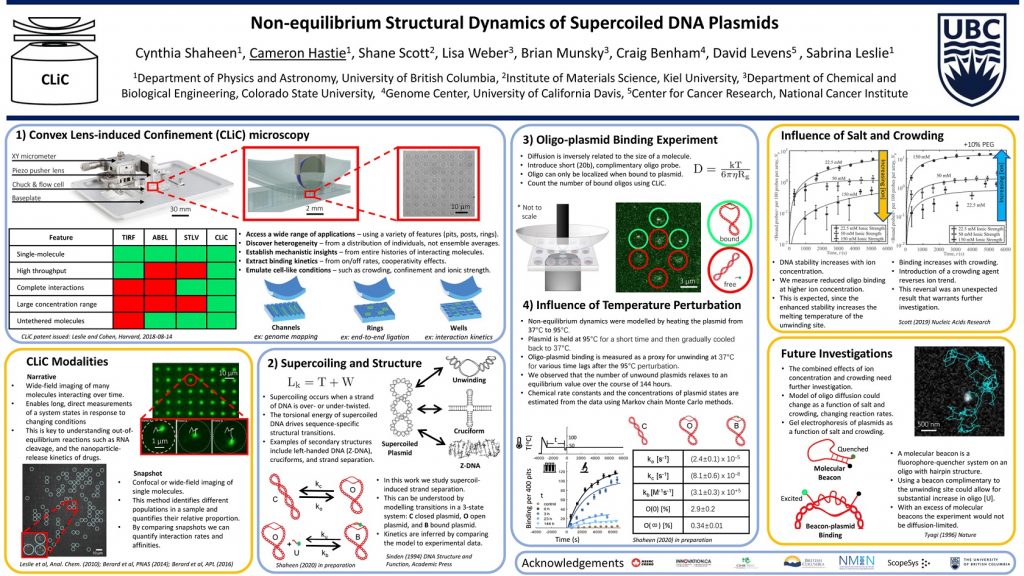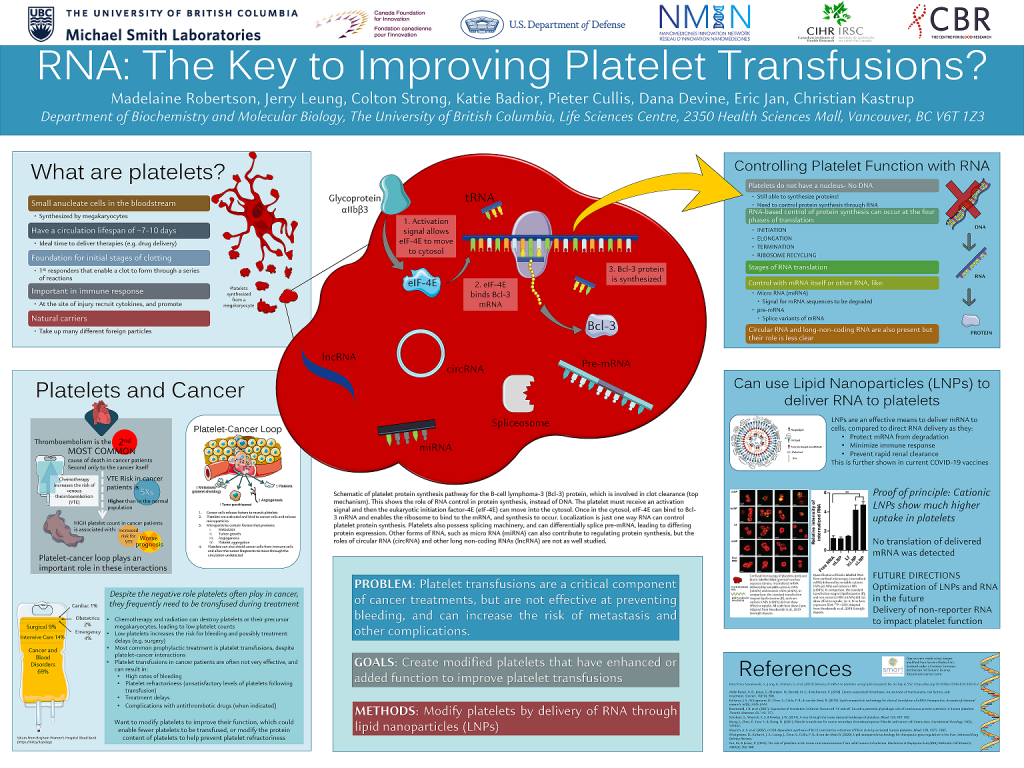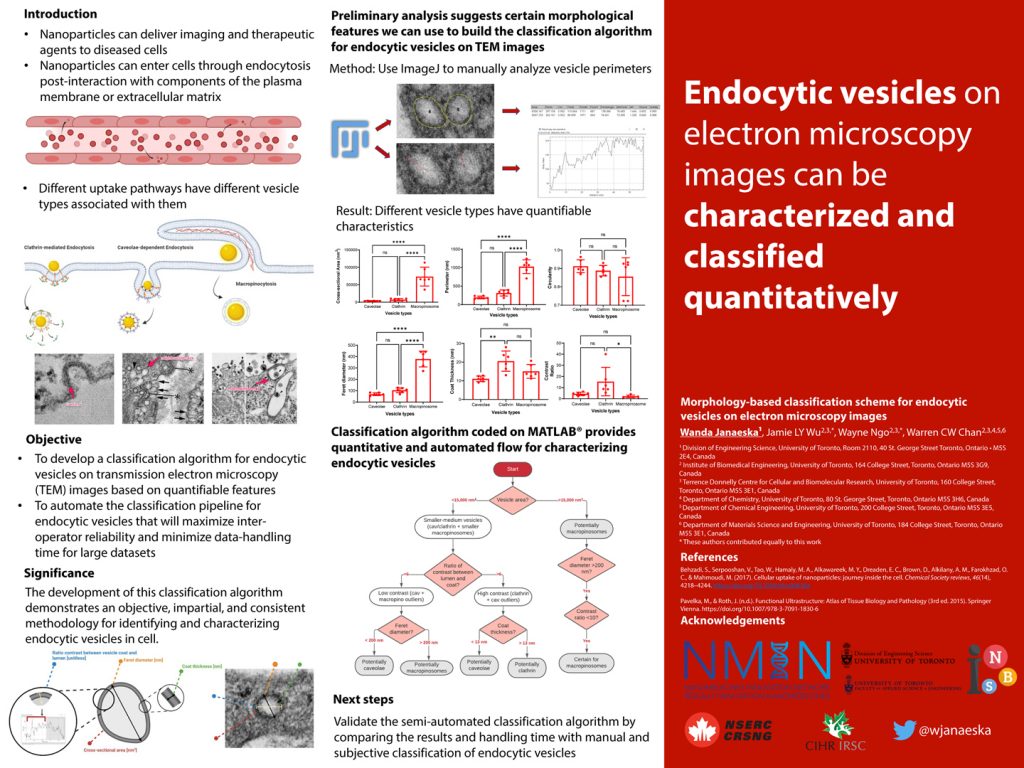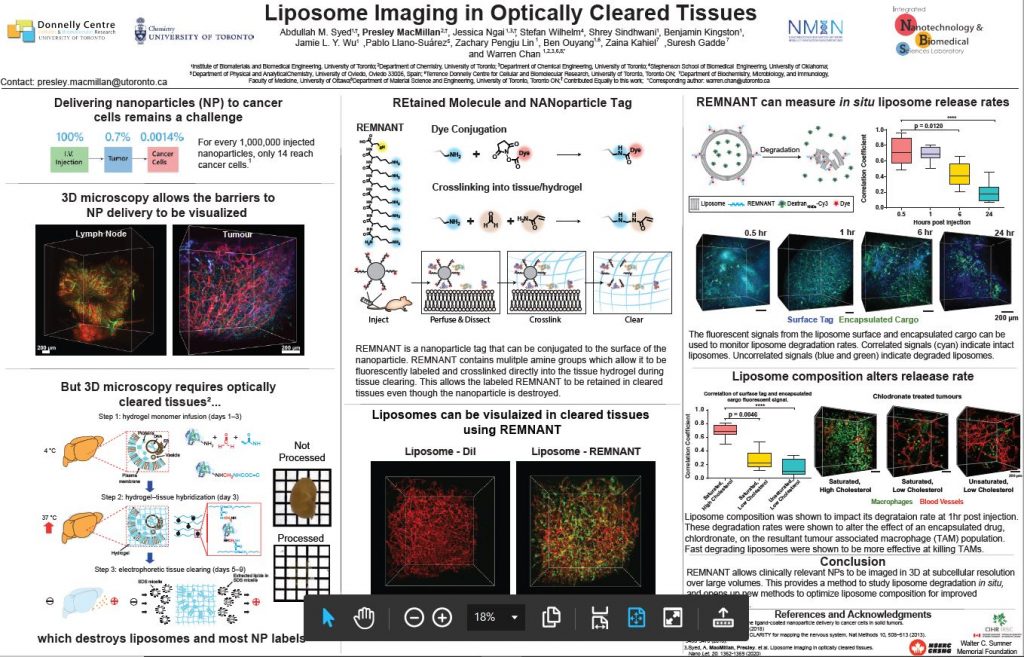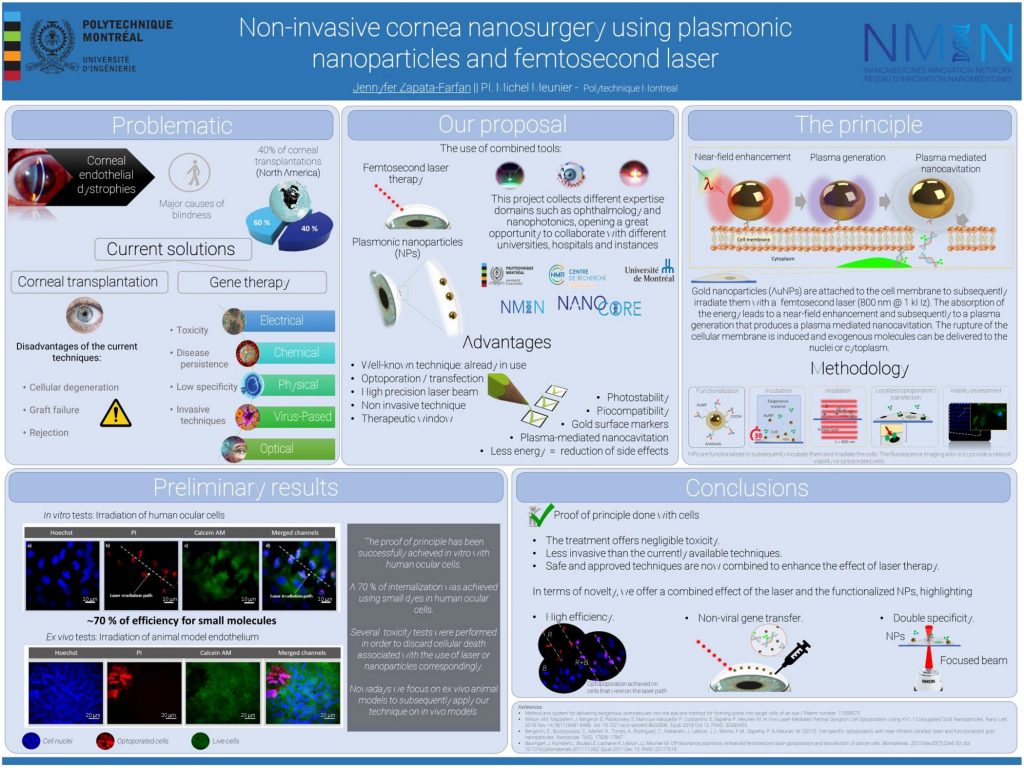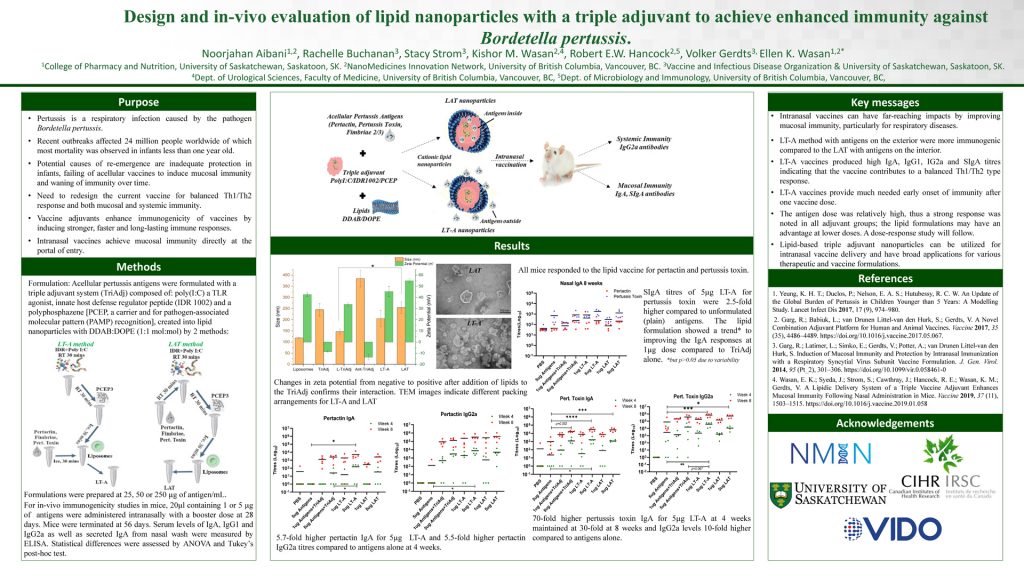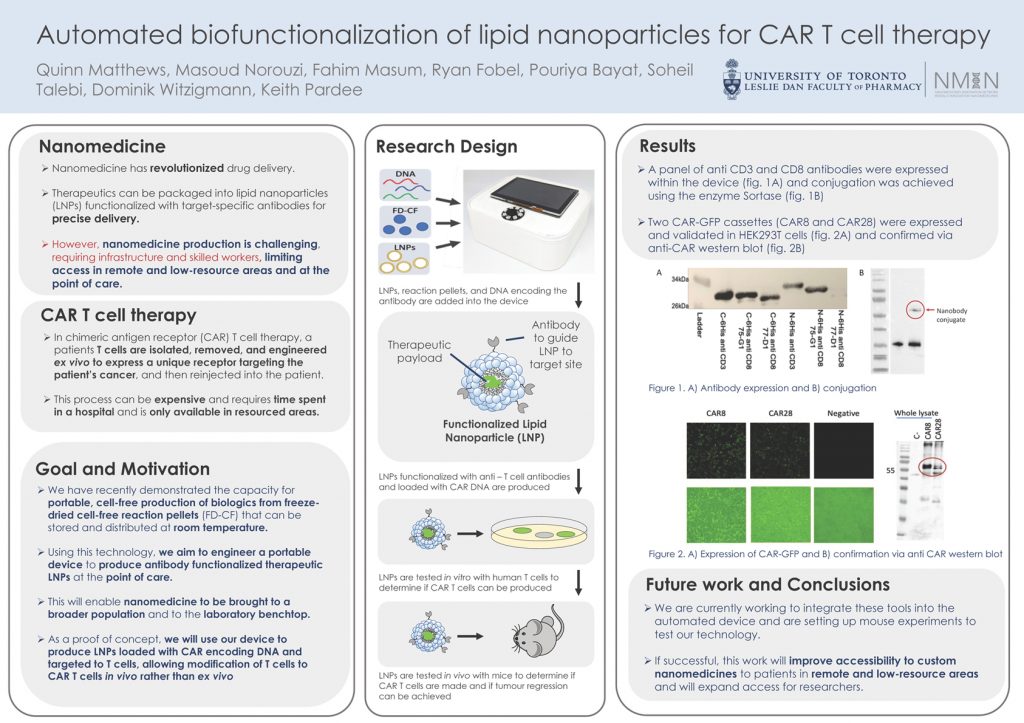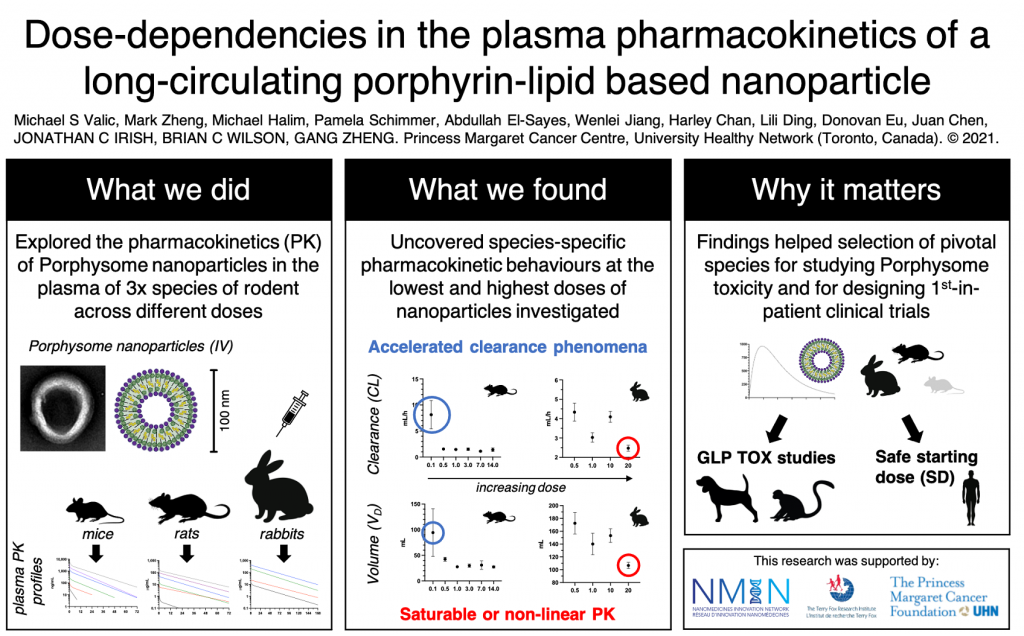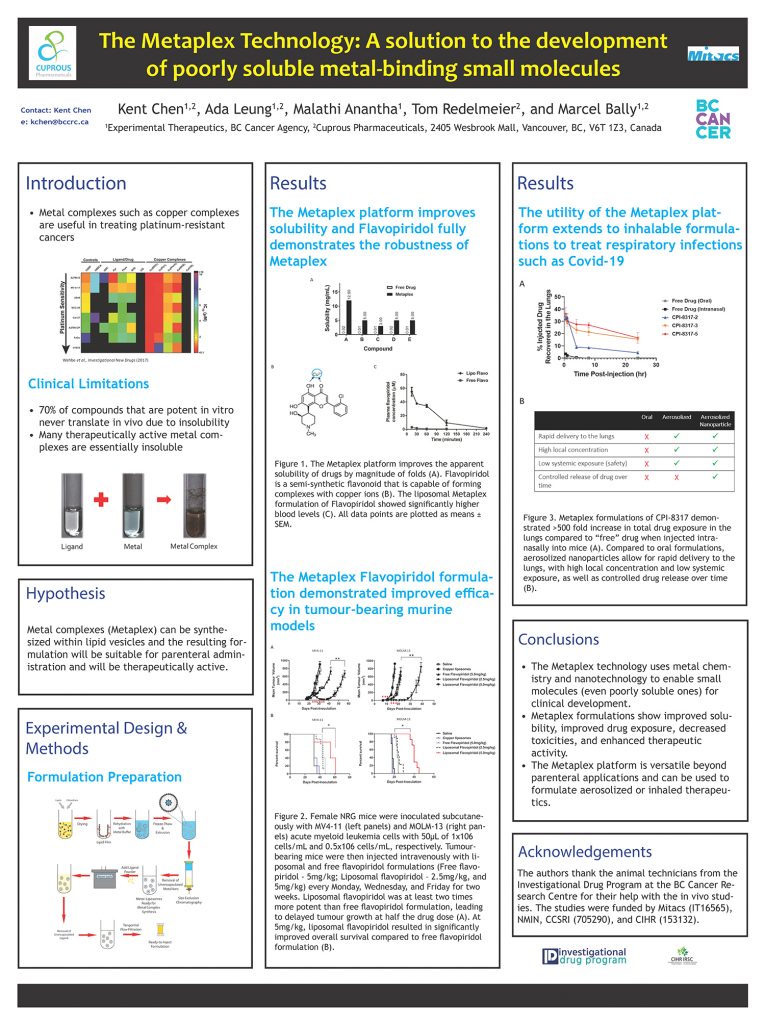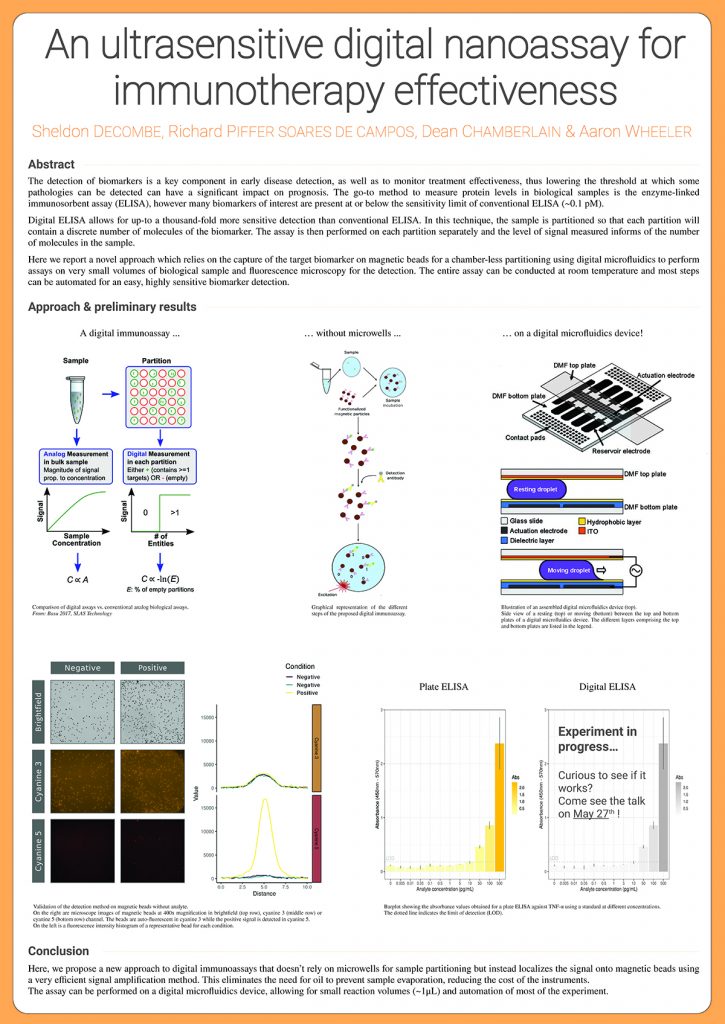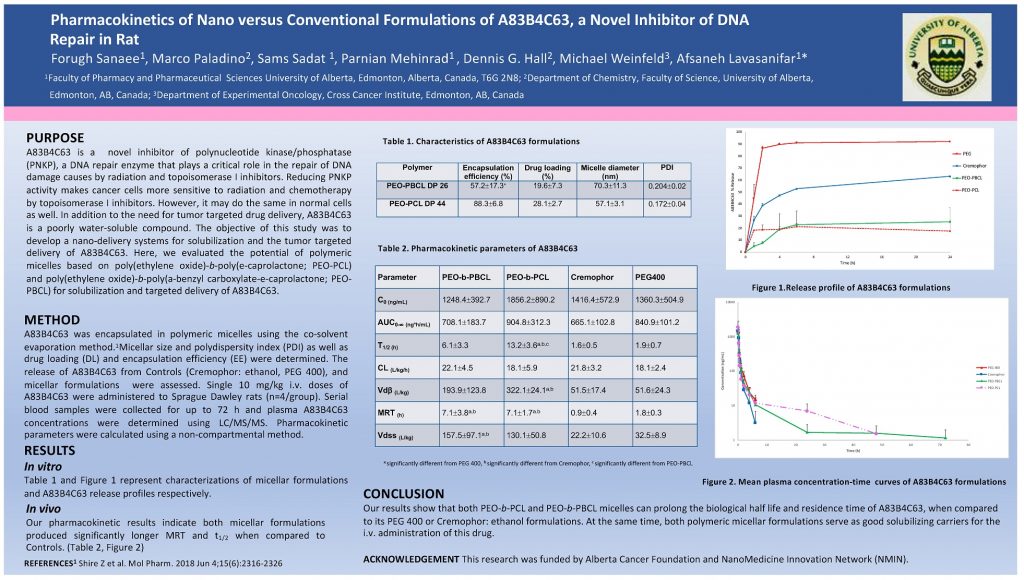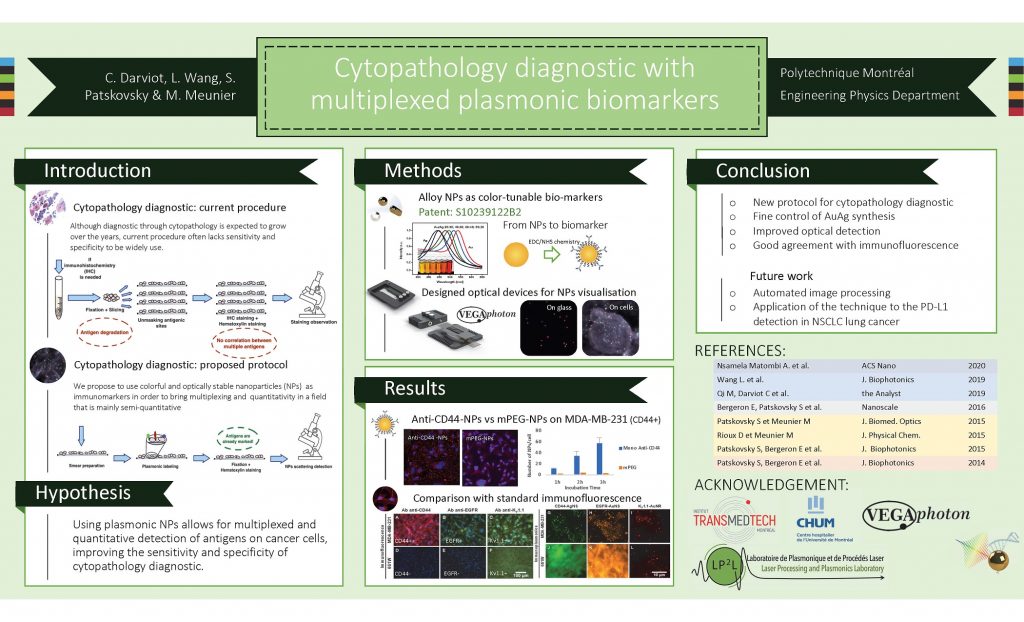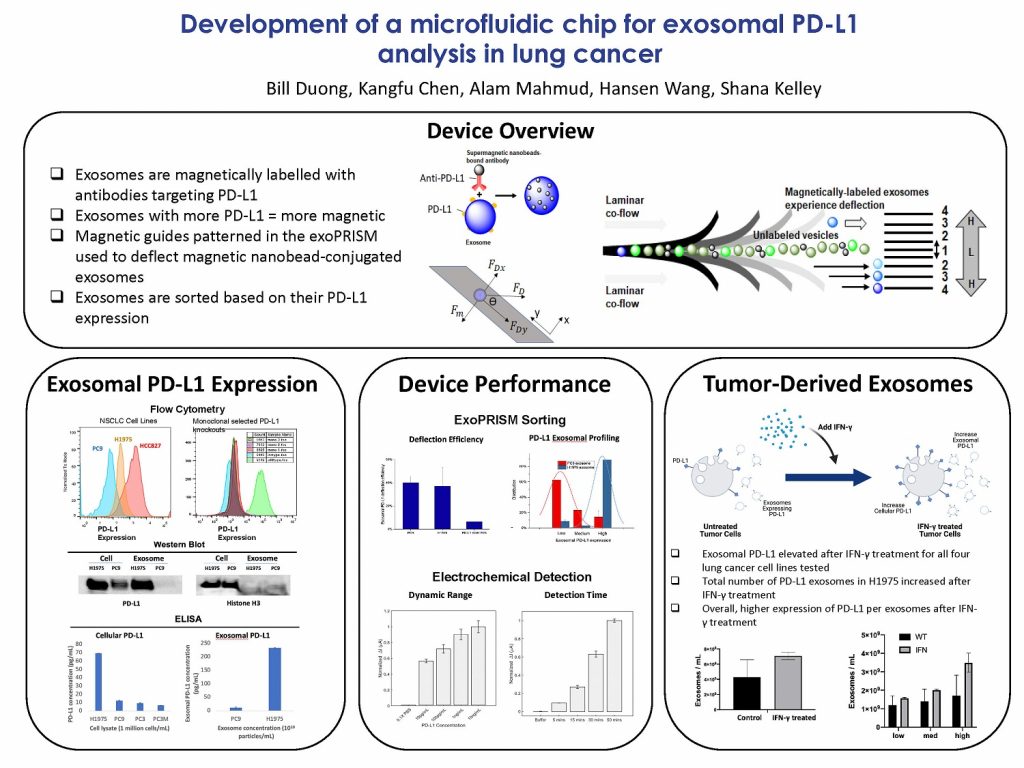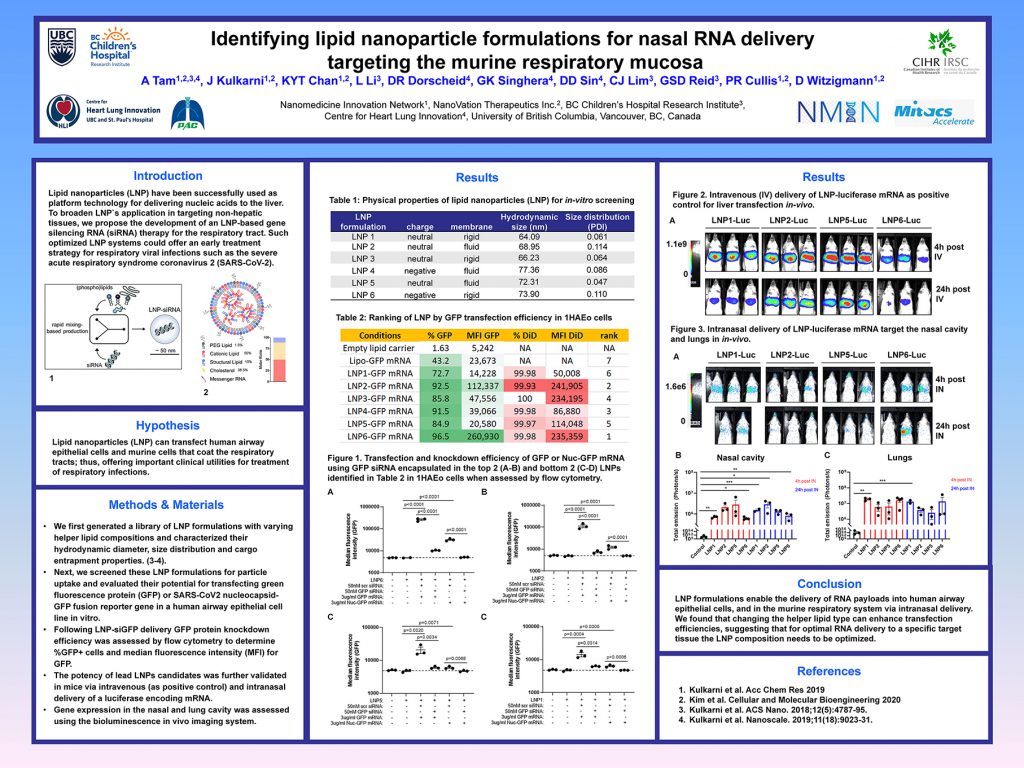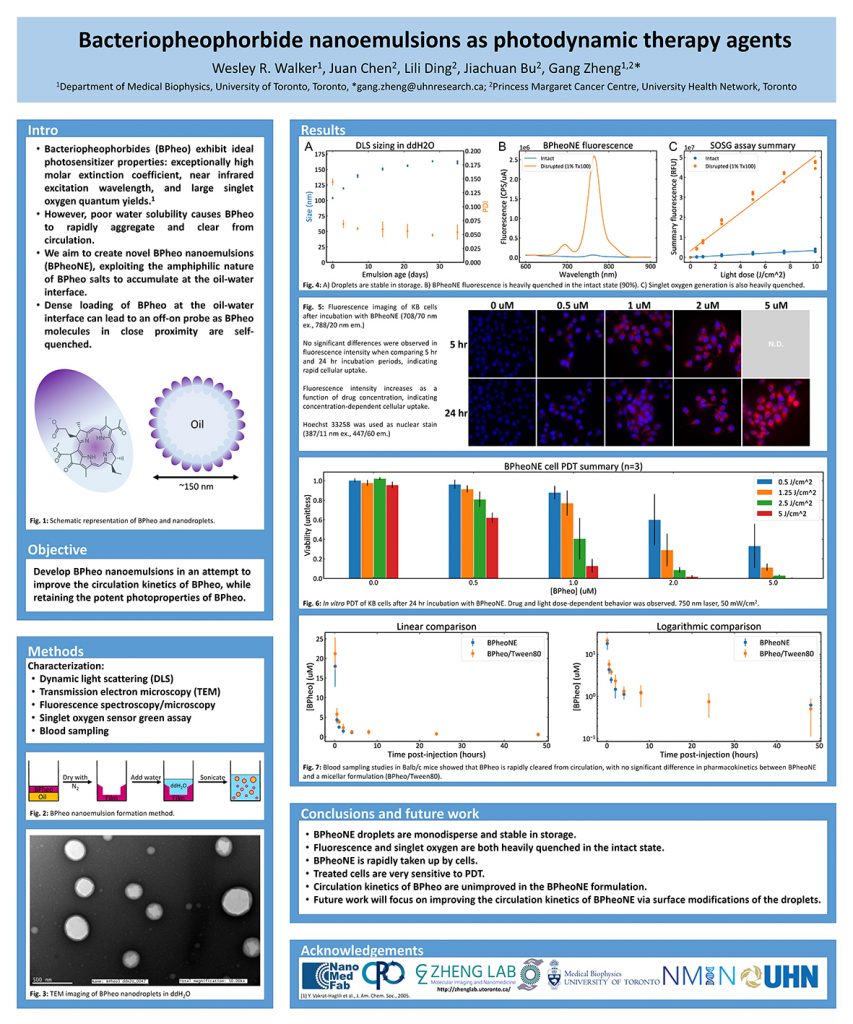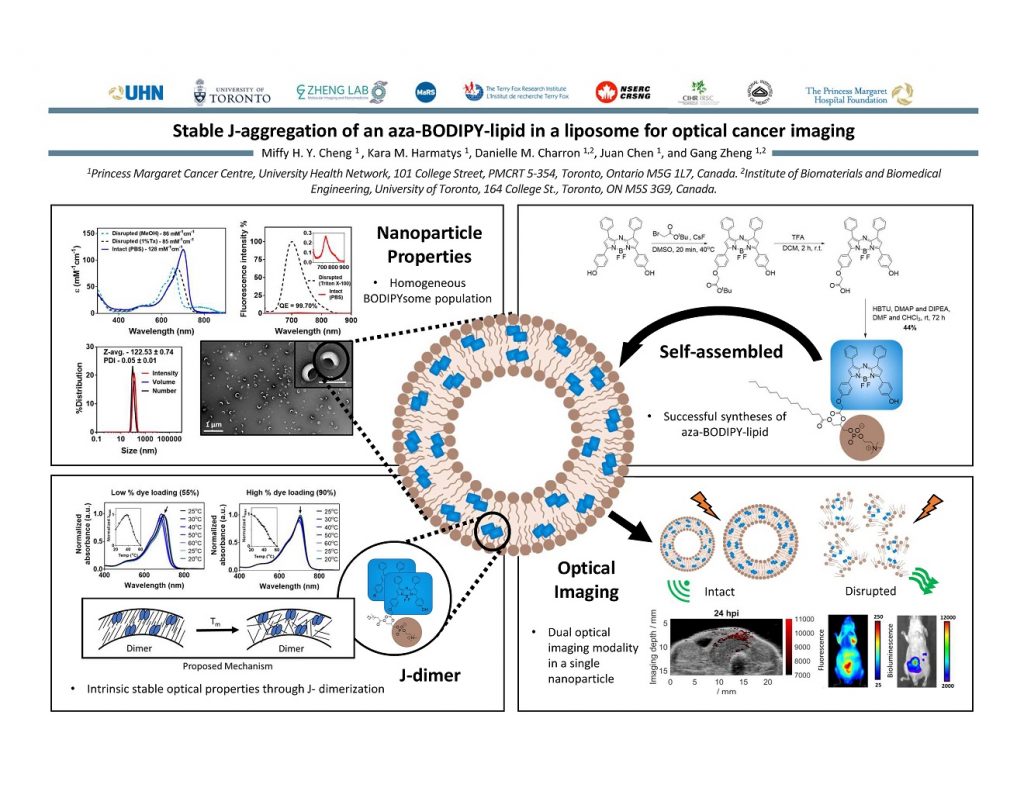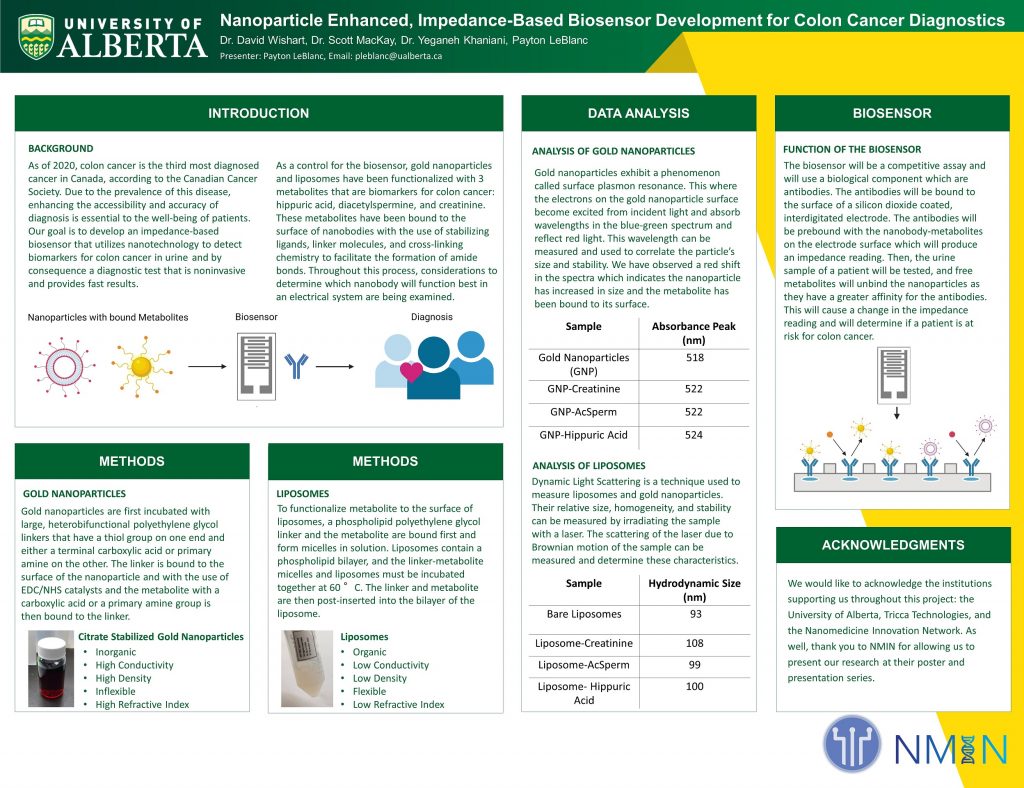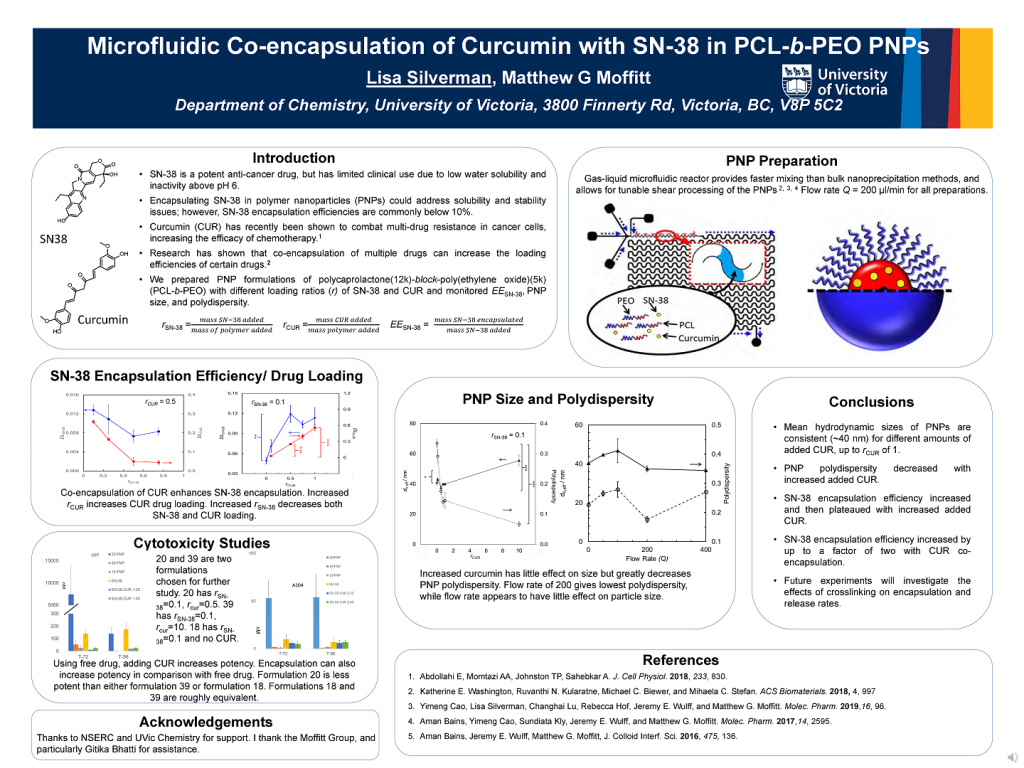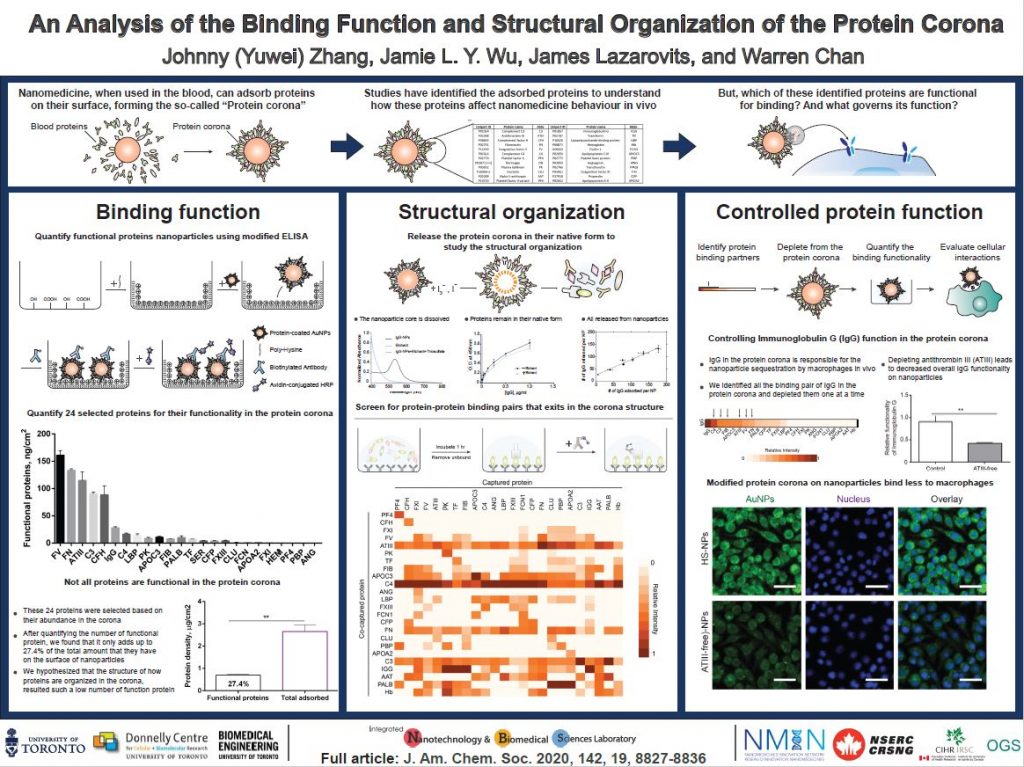NMIN
EVENTS
HQP Research Presentation Series
Ongoing
NMIN
PAST SESSIONS: 2021
2021
25 March 2021
29 April 2021
27 May 2021
29 July 2021
30 September 2021
28 October 2021
Sixth Round
NMIN HQP Research Presentations
28 October 2021
12:30 – 1:30 pm PDT | 3:30 – 4:30 pm EDT
PRESENTATIONS / POSTERS
PRESENTERS
Non-equilibrium Structural Dynamics of Supercoiled DNA Plasmids
I will discuss some recent results involving the non-equilibrium dynamics of site unwinding in supercoiled plasmid DNA and how this fits in the context of some of our group’s previous plasmid studies. The talk will also include some surprising findings, where increasing the ionic strength in a crowded environment led to an increase in site unwinding, despite the high stability of double-stranded DNA in the presence of salt. I will conclude with a brief overview of our future directions, focusing on how these studies are relevant to nucleic acid medicines and plasmids as viral vectors.
Cameron Hastie is a PhD student in the Physics and Astronomy Department at the University of British Columbia. He is a student researcher in Dr. Sabrina Leslie’s group, which is known for pioneering a single-molecule technique called convex lens-induced confinement (CLiC) microscopy. His research involves investigations of nucleic acid interactions featuring CLiC and other fluorescence microscopy techniques.
Click on the poster for a PDF version.
Please contact the poster author with any questions or comments: cameron.hastie@msl.ubc.ca
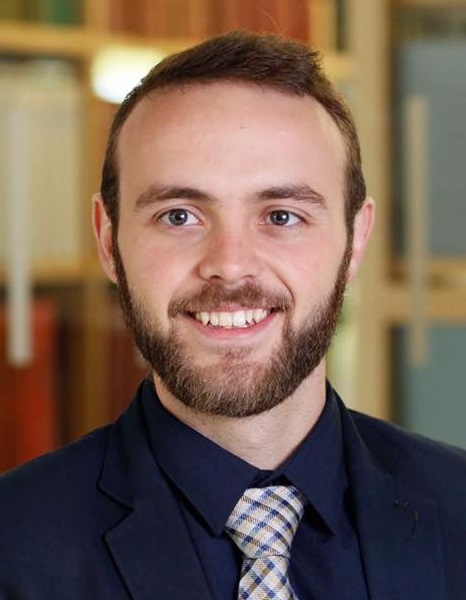
Cameron Hastie
University of British Columbia
RNA: The Key to Improving Platelet Transfusions?
Most platelet transfusions are given to cancer patients to prevent bleeding. However, these transfusions are often not very effective, and may even contribute to metastasis. To improve platelet transfusions, we propose modifying the RNA within the platelets as a starting point to control platelet function.
Madelaine Robertson completed her BSc in Biochemistry and Molecular Biology, and Neuroscience at Dalhousie University, before moving to the University of British Columbia for her MSc. She is currently a second-year master’s student in Biochemistry and Molecular Biology, co-supervised by Drs. Pieter Cullis and Christian Kastrup.
Click on the poster for a PDF version.
Please contact the poster author with any questions or comments: madelaine.robertson@msl.ubc.ca
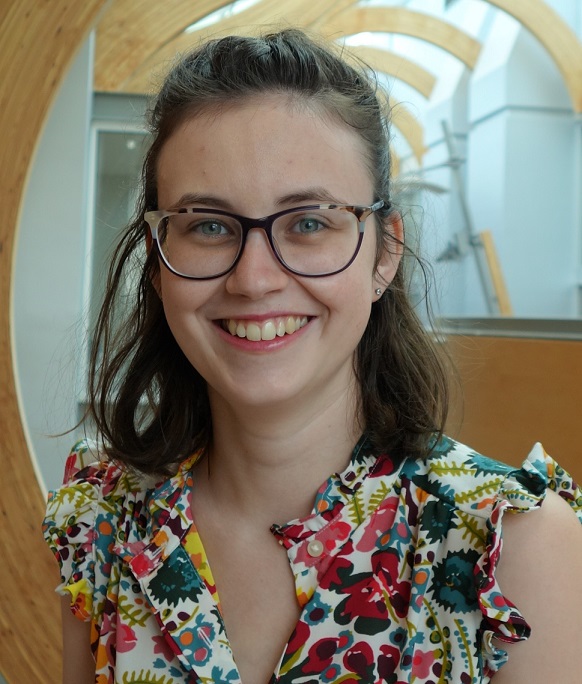
Madelaine Robertson
University of British Columbia
Development of lipid nanoparticle-enabled gene therapy approaches in the brain
Lipid nanoparticle (LNP)-enabled gene therapy is a promising approach for the treatment of genetic neurological disease. To optimize the efficacy of LNP-enabled nucleic acid delivery for this purpose, we developed an iterative screening strategy using neurons ex vivo. Here, we identify unique LNP formulation parameters for siRNA and mRNA delivery, and show that formulation potency and toxicity vary with lipid composition and dose.
Sarah Thomson is a PhD candidate in Dr. Blair Leavitt’s research group at the University of British Columbia. Her research is focused on transcriptional regulation in Huntington’s disease, and the therapeutic modulation of gene expression using nucleic acid effectors in the brain.
Click on the poster for a PDF version.
Please contact the poster author with any questions or comments: sthomson@cmmt.ubc.ca

Sarah Thomson
University of British Columbia
The HQP Research Presentation Series gives NMIN HQP the opportunity to collaboratively develop their poster presentation skills, deliver a presentation in a supportive environment, and to receive constructive feedback.
Fifth Round
NMIN HQP Research Presentations
30 September 2021
12:30 – 1:30 pm PDT | 3:30 – 4:30 pm EDT
PRESENTATIONS / POSTERS
PRESENTERS
A morphology-based classification algorithm for identifying caveolae, clathrin vesicles, and macropinosomes on electron microscopy images
Transmission electron microscopy has the resolution necessary to resolve nanoparticle-containing vesicles in cells. However, it is challenging to manually differentiate these vesicles as caveolae, clathrin, or macropinosomes. Here, we develop a classification algorithm that classifies endocytic vesicles imaged with TEM. Characterizing nanoparticle-containing vesicles helps us understand which endocytosis pathways are used by cells to transport nanoparticles.
Wanda Janaeska is a summer student in Dr. Warren Chan’s lab at the University of Toronto. She is pursuing a BASc in Engineering Science with a specialization in Biomedical Systems Engineering. She is fascinated by therapeutic designs that can better tackle diseases such as cancer. In the future, she wishes to explore the intersection of nanotechnology and cancer immunotherapy.
Click on the poster for a PDF version.
Please contact the poster author with any questions or comments: wanda.janaeska@mail.utoronto.ca

Wanda Janaeska
University of Toronto
Liposome Imaging in Optically Cleared Tissues
Three-dimensional microscopy can be used to study and improve the delivery of nanomedicines. Unfortunately, this approach is not compatible with liposomal nanoparticles because the process of rendering tissues transparent generally removes lipids. In this talk, I will describe the development of a nanoparticle tag, termed REMNANT, that enables 3D imaging of liposomes in tissues.
Presley MacMillan completed her B.Sc. (Hons) in Chemistry at Saint Mary’s University. Currently, she is a fifth-year Ph.D. student in Warren Chan’s lab at the University of Toronto. Her current research is focused on developing tools to study nanoparticle interactions in tumours.
Click on the poster for a PDF version.
Please contact the poster author with any questions or comments: presley.macmillan@utoronto.ca
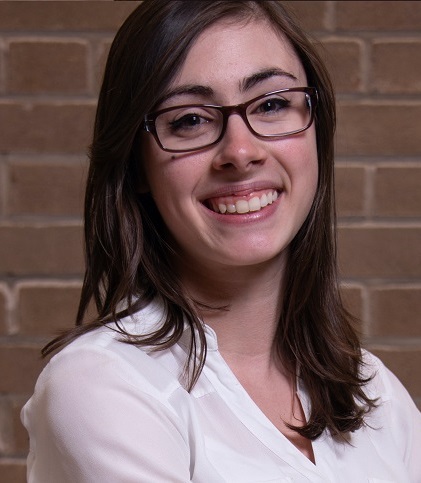
Presley MacMillan
University of Toronto
Non-invasive cornea nanosurgery using plasmonic nanoparticles and femtosecond laser
Due to the high prevalence of corneal dystrophies in North America and its important impact on the health system, we are presenting an alternative therapy for the anterior segment of the eye. Combining a femtosecond laser with plasmonic nanoparticles we perform cellular nanosurgery to treat endothelial diseases. Preliminary results in vitro showed promising results to be tested in vivo as a subsequent stage of the project. Jennyfer Zapata is a Ph.D. student enrolled in a double degree at Polytechnique Montreal Canada and the National Autonomous University of Mexico. Her research expertise includes electronic instrumentation, biophotonics, optics, and nanoplasmonics applied in ocular gene therapy.Click on the poster for a PDF version.
Please contact the poster author with any questions or comments: jennyfer.zapata-farfan@polymtl.ca
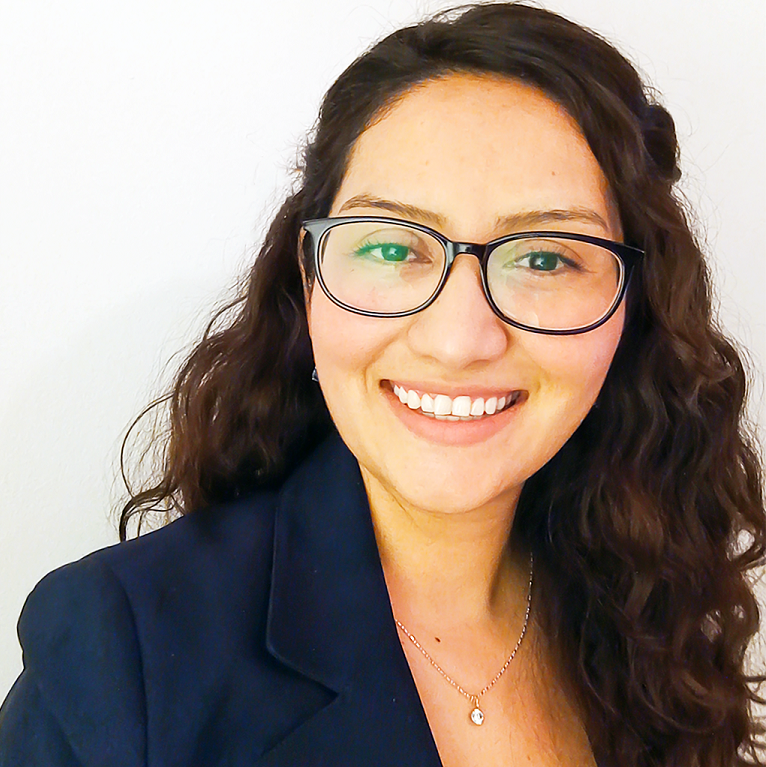
Jennyfer Zapata-Farfan
Polytechnique Montréal
Fourth Round
NMIN HQP Research Presentations
29 July 2021
12:30 – 1:30 pm PDT | 3:30 – 4:30 pm EDT
PRESENTATIONS / POSTERS
PRESENTERS
Design and in-vivo evaluation of lipid nanoparticles with a triple adjuvant to achieve enhanced immunity against Bordetella pertussis
Achieving mucosal immunity along with systemic immunity is an important aspect of respiratory vaccine development. Recent Pertussis outbreaks indicate the need to reformulate Pertussis vaccine to achieve early and efficient protection against infection. This presentation will describe the designing of an acellular Pertussis vaccine with cationic lipids and triple adjuvant. Along the way it will discuss the increase in IgG1, IgG2a and IgA antibodies response of lipid nanoparticle formulations; how the packing of antigens with the lipids affects their antigenic properties in-vivo; and which antigens have the best antigenic properties. The presentation will demonstrate that lipidic triple adjuvant nanoparticles have the potential to achieve effective immunity against Pertussis infections and provide the much needed early onset of immunity after one vaccine dose.
Noorjahan Aibani is a Postdoctoral Fellow with Dr. Ellen Wasan at the College of Pharmacy and Nutrition, University of Saskatchewan and recipient of the inaugural NMIN Postdoctoral Fellow award. She earned her PhD at Ulster University, Northern Ireland, UK. Noorjahan carries out her research in advanced and targeted drug delivery.
Click on the poster for a PDF version.
Please contact the poster author with any questions or comments: noorjahanaibani@gmail.com

Noorjahan Aibani
University of Saskatchewan
A platform for automated functionalization of lipid nanoparticles for CAR T cell therapy
Nanomedicine has transformed drug delivery by allowing targeted drug delivery, but it’s application can be limited by production and distribution challenges. Here, we aim to build a device that will enable de-centralized and on-demand production of antibody-functionalized LNPs using cell-free protein synthesis. As a proof of concept, we aim to produce LNPs capable of producing cancer-killing CAR T cells in leukemic mice.
Quinn Matthews, originally from Vancouver, joined Professor Keith Pardee’s research group as an MSc student in 2019. He is passionate about decentralizing science/healthcare and is involved in a few projects within the lab that aim to solve real-life problems using synthetic biology. Outside the lab, he enjoys boxing, cycling, and being in the great outdoors.
Click on the poster for a PDF version.
Please contact the poster author with any questions or comments: quinn.matthews@mail.utoronto.ca
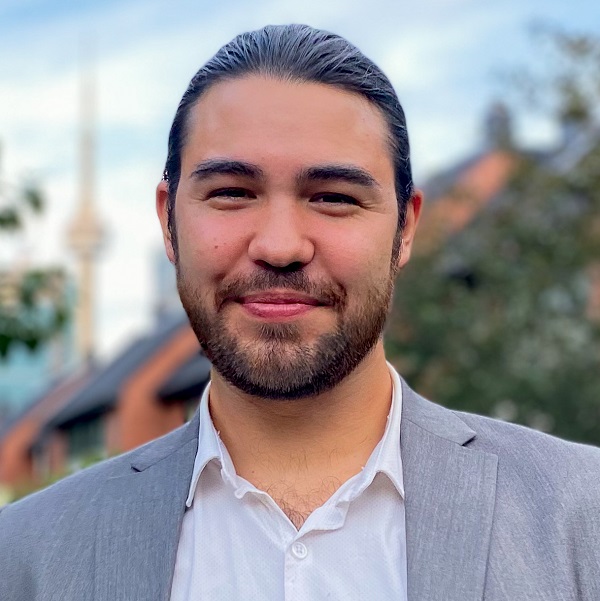
Quinn Matthews
University of Toronto
Dose-dependencies in the plasma pharmacokinetics of a long-circulating porphyrin-lipid based nanoparticle
A liposome-like nanoparticle (a.k.a. Porphysome) was intravenously administered with escalating doses to mice, rats, and rabbits. We found that the plasma pharmacokinetic parameters were dose invariant over a broad dose range within each species. Comparing parameter values at equivalent doses between species highlighted differences that may be understood and predicted using allometric scaling.
Michael Valic is a Ph.D. candidate with Prof. Gang Zheng at the Institute for Biomedical Engineering, University of Toronto. He studies the pharmacokinetics and pharmacodynamics of porphyrin-based nanomaterials with applications in cancer and regenerative medicine.
Click on the poster to enlarge.
Please contact the poster author with any questions or comments: michael.valic@porphysome.ca

Michael Valic
University of Toronto
Third Round
NMIN HQP Research Presentations
27 May 2021
12:30 – 1:30 pm PDT | 3:30 – 4:30 pm EDT
PRESENTATIONS / POSTERS
Posters coming soon – please check back
PRESENTERS
The Metaplex Technology: A solution to the development of poorly soluble metal-binding small molecules
Metaplex is a technology platform that uses a transmembrane metal gradient to encapsulate small molecules into liposomes. The technology platform ameliorates formulation challenges of poorly soluble drug candidates.
Kent Chen is a Mitacs post-doctoral research fellow at Cuprous Pharmaceuticals in Vancouver, Canada. His research focuses on the development of liposomal formulations for the treatment of various disease indications from viral infections to cancer.
Poster coming soon – please check back
Click on the poster for a PDF version.
Please contact the poster author with any questions or comments: kchen@bccrc.ca

Dr. Kent Chen
Cuprous Pharmaceuticals
An ultrasensitive digital nanoassay for immunotherapy effectiveness
I will introduce digital microfluidics (DMF) then present the idea of running a digital ELISA without partitioning the sample and finally show the result we got so far and what we are planning to do in the near future.
Sheldon Decombe has been a postdoc in Aaron Wheeler’s lab at the University of Toronto for about 6 months. He has a PhD in molecular biology and an MBA and he is currently working on developing biology techniques and assays on the DMF platform.
Click on the poster for a PDF version.
Please contact the poster author with any questions or comments: sheldon.decombe@utoronto.ca
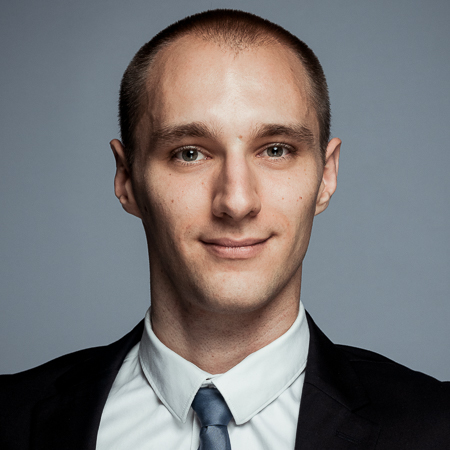
Sheldon Decombe
University of Toronto
Pharmacokinetics of Nano versus Conventional Formulations of A83B4C63, a Novel Inhibitor of DNA Repair in Rat
My research project was to develop a nano-carrier formulation for a novel PNKP inhibitor known as A83B4C63, for tumor targeted inhibition of DNA repair in solid tumors. In this context, nanoparticles of A83B4C63 were prepared and characterized for their average diameter, polydispersity, drug loading and in vitro release properties, and the pharmacokinetics of encapsulated A83B4C63 was assessed following i.v. administration in rats.
Forugh Sanaee is a Post-doctoral fellow in the Department of Pharmaceutical Sciences at the University of Toronto, where she recently joined Dr. Christine Allen’s research group. She previously received a Pharm D from a university in Iran, and completed her PhD in pharmacokinetics at the University of Alberta. The current presentation is based on her work under the supervision of Dr. Afsaneh Lavasanifar at University of Alberta.
Click on the poster for a PDF version.
Please contact the poster author with any questions or comments: forugh.sanaee@utoronto.ca
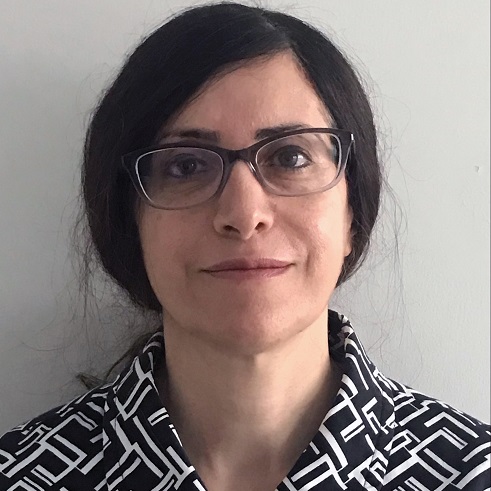
Forugh Sanaee
University of Toronto
The HQP Research Presentation Series gives NMIN HQP the opportunity to collaboratively develop their poster presentation skills, deliver a presentation in a supportive environment, and to receive constructive feedback.
Second Round
NMIN HQP Research Presentations
Thursday 29 April 2021
12:30 – 1:30 pm PDT | 3:30 – 4:30 pm EDT
PRESENTERS
Cytopathology diagnostic with multiplexed plasmonic biomarkers
We present herein the development of a new technique, based on plasmonic labeling of live cells before fixation to improve the reliability of cytopathology diagnosis. This cost-effective and sensitive methodology is based on the optical properties of spectrally distinct metallic nanoparticles (NPs), in this case gold and gold-silver alloy NPs, conjugated with specific antibodies to target specific antigens.
Cécile Darviot obtained her engineering degree from École Centrale de Lille and her master’s degree from Polytechnique Montréal in 2018. After studying in vitro a new treatment for retinoblastoma based on the interaction between plasmonic nanoparticles and a nanosecond laser during her master’s thesis, she began a PhD at Polytechnique Montréal, in engineering physics, in January 2019. Her research project mainly focuses on hyperspectral optical imaging of plasmonic biomarkers for a wide range of biomedical applications including cyto– and histopathology.
Click on the poster for a PDF version.
Please contact the poster author with any questions or comments: cecile.darviot@gmail.com
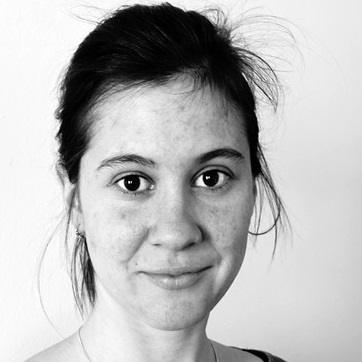
Cécile Darviot
École Polytechnique de Montréal
Development of a microfluidic chip for exosomal PD-L1 analysis in lung cancer
The use of exosomes as cancer biomarkers is receiving much attention lately due to recent discoveries of their involvement in key cancer physiological pathways. Unfortunately, exosomes are very hard to isolate and detect due to their small sizes. In the Kelley Lab, we have developed a technology that allows for the isolation and sorting of exosomes based on their protein biomarkers expression, while also maintaining their integrity for downstream analysis.
Bill Duong is a fifth year PhD student in the Shana Kelley laboratory. Currently he is enrolled in the chemistry department at the University of Toronto. His research focuses on developing and utilizing Microfluidics devices for the understanding of rare cancer cells and biomarkers to further understand cancer development and improve cancer screening.
Click on the poster for a PDF version.
Please contact the poster author with any questions or comments: bill.duong@mail.utoronto.ca

Bill Duong
University of Toronto
Identifying lipid nanoparticle formulations for nasal RNA delivery targeting the murine respiratory mucosa
Lipid nanoparticles (LNP) have been successfully used as platform technology for delivering nucleic acids to the liver. To broaden LNP’s application in targeting non-hepatic tissues, we propose the development of an LNP-based gene silencing RNA (siRNA) therapy for the respiratory tract. Such optimized LNP systems could offer an early treatment strategy for respiratory viral infections such as the severe acute respiratory syndrome coronavirus 2 (SARS-CoV-2).
Anthony Tam graduated with a BSc in Biochemistry from the University of British Columbia and pursued his PhD training at the Centre for Heart Lung Innovation at St. Paul’s Hospital. His PhD research showed sex-related differences in a murine model of Chronic Obstructive Pulmonary Disease. He then pursued post-doctoral training at BC Children’s Hospital on gene editing and identified a novel mechanism controlling airway tissue remodeling. Recently, he joined Nanovation Therapeutics as a research scientist on the use of nanomedicine in targeting different tissue disease types.
Click on the poster for a PDF version.
Please contact the poster author with any questions or comments: a.tam@nanovationtx.com
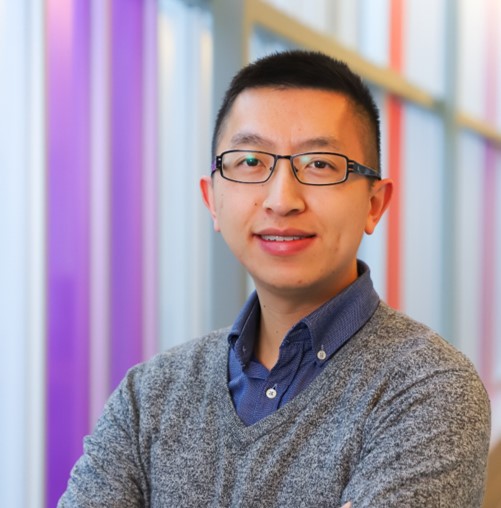
Dr. Anthony Tam
Nanovation Therapeutics
Bacteriopheophorbide nanoemulsions as photodynamic therapy agents
Bacteriochlorins are bio-compatible dyes which are well suited for photodynamic therapy due to their near infrared excitation wavelengths and high molar absorption coefficients. However, bacteriochlorins have limited utility in-vivo due to poor circulation kinetics. In this talk, I will describe our attempts at improving these circulation kinetics by creating novel bacteriochlorin-based nanoemulsions.
Wesley Walker received his BASc in Nanotechnology Engineering from the University of Waterloo, before moving to pursue an MSc in Medical Biophysics at the University of Toronto. Under the supervision of Dr. Gang Zheng, he is developing bacteriochlorin-based nanoemulsions for use in the treatment of cancer.
Poster coming soon – please check back
Click on the poster for a PDF version.
Please contact the poster author with any questions or comments: wesley.walker@mail.utoronto.ca

Wesley Walker
University of Toronto
The HQP Research Presentation Series gives NMIN HQP the opportunity to collaboratively develop their poster presentation skills, deliver a presentation in a supportive environment, and to receive constructive feedback.
First Round
Thursday 25 March 2021
12:30 – 1:30 pm PDT | 3:30 – 4:30 pm EDT
PRESENTATIONS / POSTERS
PRESENTERS
Stable J-aggregation of an aza- BODIPY-lipid in a liposome for optical cancer imaging
We present the synthesis of a novel aza-BODIPY-lipid building block and its self-assembly into BODIPYsome, which has optically stable NIR J-aggregation that is attributed to -J-dimerization. BODIPYsomes exhibit a high extinction coefficient and high fluorescence quenching, enabling photoacoustic when intact and recovered NIR fluorescence once disrupted for in vivo cancer imaging.
Miffy Hok Yan Cheng received her B.Sc. (Hons) in Chemistry with Molecular Medicine in 2014 from the University of Hull, UK. She obtained a Ph.D. degree in Chemistry with Prof Ross Boyle in 2018 at the same institution. Her PhD studies included the development of NIR fluorescence probe and the bioconjugation to targeting moieties such as antibodies and peptides. After her PhD, she began her postdoctoral fellow position in Princess Margaret Cancer Centre with Prof Gang Zheng in 2018, and since her research has been focused on the synthesis and development of organic building blocks for lipid-based nanotechnologies in biomedical imaging.
Click on the poster for a PDF version.
Please contact the poster author with any questions or comments: hok-yan.cheng@uhnresearch.ca
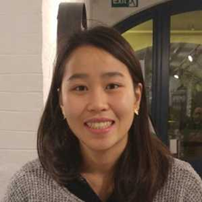
Miffy Cheng
Princess Margaret Cancer Centre
Nanoparticle Enhanced, Impedance-Based Biosensor Development for Cancer Diagnosis
Current research shows urinary metabolites can be classified as biomarkers for colon cancer. Colon cancer is primarily diagnosed with colonoscopies and blood tests: both of which are extremely invasive. It is our goal to develop a biosensor that uses nanoparticles bound with metabolites for normalization, to detect the presence of free metabolites in the urine samples of patients.
Payton LeBlanc is a third year student completing her Bachelor of Science specializing in Immunology and Infection. She is currently interning as an undergraduate researcher at the Wishart Lab located at the University of Alberta. For the past six months, she has participated in developing an impedance-based biosensor that utilizes nanoparticles to enhance colon cancer diagnostics.
Click on the poster for a PDF version.
Please contact the poster author with any questions or comments: pleblanc@ualberta.ca

Payton LeBlanc
University of Alberta
Microfluidic Co-encapsulation of Curcumin with SN-38 in PCL-block-PEO Polymer Nanoparticles
In this presentation, I describe my work co-encapsulating the chemotherapy drug SN-38 with curcumin in polymer nanoparticles, using microfluidic nanoprecipitation. Curcumin improves the encapsulation efficiency of SN-38 and changes the physico-chemical properties of the particle.
Liza Silverman graduated from MIT with a BSc in biology and from Hebrew University of Jerusalem with an MSc in biochemistry. She is currently a PhD candidate at the University of Victoria in the department of chemistry, studying nanoparticles for drug delivery. She also studied nanoparticles, and particularly Doxil, while working in industry. Her current research in the group of Prof. Matt Moffitt focuses on encapsulating SN-38 in polymer nanoparticles. She is working to increase the encapsulation efficiency of SN-38. When not in the lab, Liza enjoys knitting and being anywhere near the ocean.
Click on the poster for a PDF version.
Please contact the poster author with any questions or comments: silverman.liza@gmail.com
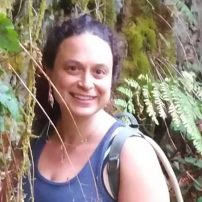
Liza Silverman
University of Victoria
An analysis of the function and structure of the protein corona on nanoparticles
Nanomaterials can adsorb blood proteins on their surface, forming the so-called protein corona. In this study, we studied the function and structure of these adsorbed proteins. We also demonstrated how this information could help us design better nanomaterials for in vivo use.
Johnny Zhang is a 5th year PhD student from Professor Warren Chan’s lab at the University of Toronto. He studies nanomaterial-protein interactions and designs functional nanomaterials for applications in medicine. He also develops immunoassay using nanomaterials for diagnosing infectious diseases like SARS-CoV-2. He obtained BSc from Mount Allison University with First Class Honours with distinction.
Click on the poster for a PDF version.
Please contact the poster author with any questions or comments: johnnykta.zhang@mail.utoronto.ca

Johnny Zhang
University of Toronto
The HQP Research Presentation Series gives NMIN HQP the opportunity to collaboratively develop their poster presentation skills, deliver a presentation in a supportive environment, and to receive constructive feedback.
